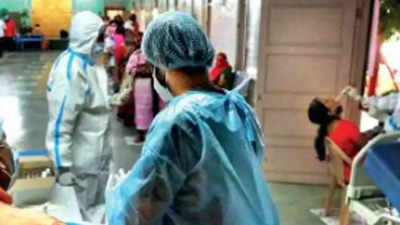- News
- City News
- chandigarh News
- Covid-19: In Punjab, rapid spread but low hospitalisations
Trending
This story is from January 13, 2022
Covid-19: In Punjab, rapid spread but low hospitalisations
Even as Punjab has noted a rise in the number of hospitalisations since the onset of the third wave of infection, the proportion of infected persons requiring care at health facilities is far less than the count of patients admitted in hospitals during the devastating second wave last

Picture used for representational purpose only
CHANDIGARH: Even as Punjab has noted a rise in the number of hospitalisations since the onset of the third wave of infection, the proportion of infected persons requiring care at health facilities is far less than the count of patients admitted in hospitals during the devastating second wave last year.
As the fresh wave of infection that is believed to be caused by the Omicron variant is spreading more rapidly, health experts have warned that it is too early to conclude that the new variant is less virulent and fatal version of Covid than the other variants of concern.Omicron has so far been detected in 61 samples, the count of which is projected to rise manifold in coming weeks, replacing Delta as the most dominating lineage of Covid in Punjab.
In the first 11 days of 2022, the state recorded 25,089 cases, over 16 times higher than the collective number of 1,531 cases recorded in December, which was the highest monthly count since July last year when 3,495 patient’s had contracted the virus.
An analysis of data reveals that the number of patients requiring hospitalisation jumped from 31-23 on oxygen support and 8 in critical care from January 1 to 442–338 on oxygen support, 91 in critical care and 13 on ventilator support on January 11, when the state had 23,235 active cases. The percentage of active cases in the hospital on January 1 and 11 was 2.97% and 1.90%, respectively. In most cases, infected persons are either asymptomatic or having mild symptoms and are recovering in home isolation.
Since the beginning of the pandemic, the percentage of infections across all age groups have remained almost the same.
Punjab Covid-19 nodal officer Dr Rajesh Bhaskar warned that the situation can change in no time if people start taking the situation lightly. “The proportion of infected persons requiring hospital is less than the second wave at the moment, which can change if people stop taking precautions. The threat posed by the virus is still the same and people should follow the health guidelines and get vaccinated,” said Dr Bhaskar.
As the fresh wave of infection that is believed to be caused by the Omicron variant is spreading more rapidly, health experts have warned that it is too early to conclude that the new variant is less virulent and fatal version of Covid than the other variants of concern.Omicron has so far been detected in 61 samples, the count of which is projected to rise manifold in coming weeks, replacing Delta as the most dominating lineage of Covid in Punjab.
In the first 11 days of 2022, the state recorded 25,089 cases, over 16 times higher than the collective number of 1,531 cases recorded in December, which was the highest monthly count since July last year when 3,495 patient’s had contracted the virus.
An analysis of data reveals that the number of patients requiring hospitalisation jumped from 31-23 on oxygen support and 8 in critical care from January 1 to 442–338 on oxygen support, 91 in critical care and 13 on ventilator support on January 11, when the state had 23,235 active cases. The percentage of active cases in the hospital on January 1 and 11 was 2.97% and 1.90%, respectively. In most cases, infected persons are either asymptomatic or having mild symptoms and are recovering in home isolation.
At a similar stage of the second wave triggered by the Delta variant, when there were 24,454 active cases on June 5, 5,323 (21.76%) infected persons were undergoing treatment — 3,424 on oxygen support, 704 in critical care centres and 295 on ventilators — at different health facilities across the state.
Since the beginning of the pandemic, the percentage of infections across all age groups have remained almost the same.
Punjab Covid-19 nodal officer Dr Rajesh Bhaskar warned that the situation can change in no time if people start taking the situation lightly. “The proportion of infected persons requiring hospital is less than the second wave at the moment, which can change if people stop taking precautions. The threat posed by the virus is still the same and people should follow the health guidelines and get vaccinated,” said Dr Bhaskar.
End of Article
FOLLOW US ON SOCIAL MEDIA











